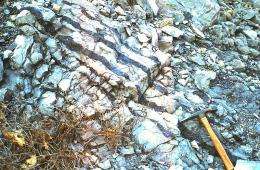May 17, 2011 report
Japanese geologist finds oldest known micrometeorite

(PhysOrg.com) -- Japanese geologist Tetsuji Onoue, of Kagoshima University, after studying chert rock (a form of microcrystalline quartz) he’d taken from Ajiro Island off the southern coast of Honshu, Japan, has discovered the oldest known bits of space dust to have fallen on the Earth. At an estimated age of 240 million years old, the microscopic iron rich spheroids, are some 50 million years older than any other space dust ever found on Earth.
In a paper published in Geology, Onoue, et al., describe how in order to find the micrometeorites hidden in the chert, they had to first crush the rock, then run it through a sieve; after which it was cleaned and then sifted with a magnet. They then examined the results using an electron microscope and found the spheroids, which are only about 10 microns across. All in all they found 260 specimens, of which, save two, had melted.
Space dust, which falls on the Earth every year at a rate of some 30,000 tons a year, is thought to mostly come from comets and asteroids, and is very hard to find due to its small size and the way it’s scattered about as it falls; and of course, because of environmental conditions. To have survived intact for all this time, the specimens found would have had to first survive being burned up completely (as happens to up to 90% of the dust that arrives here) in the atmosphere as they fell, then they would have had to fall into some sediment that would encase them, and hold their delicate structures safely in place for all these millions of years.
In addition to serving as an example of the stuff falling on us from space millions of years ago, the samples also help geological scientists piece together the puzzle of accretion (the addition of new material added to the surface of the Earth) and whether there are, or were, patterns of different stuff falling over time, and if so, how much.
And finally, because of the difficulty of finding micrometeorite samples, there are few geologists willing to spend their time looking, thus Dr. Onoue’s efforts as well has his results should be lauded as the extraordinary accomplishment that it is.
More information: Composition and accretion rate of fossil micrometeorites recovered in Middle Triassic deep-sea deposits, Tetsuji Onoue, Tomoki Nakamura, Takeshi Haranosono and Chika Yasuda, Geology, First published online May 4, 2011, doi: 10.1130/G31866.1
Abstract
Micrometeorites, which are submillimeter-sized extraterrestrial particles that survive atmospheric entry, originate from dust-producing objects such as comets and asteroids. Although ancient micrometeorites found in sedimentary rocks are of key interest as a historical record of meteoroid populations in the solar system, they are rare and prone to severe chemical weathering. Here we report the recovery of well-preserved micrometeorites, older than 240 Ma, in radiolarian chert from Japan. The collection of micrometeorites comprised 258 cosmic spherules, which are particles that totally melted during atmospheric entry, and 2 coarse-grained unmelted micrometeorites. These micrometeorites are much older than any previous micrometeorite collection in the sedimentary record. Using this collection, we calculated the accretion rate of iron-type cosmic spherules to the Earth during the Anisian Stage of the Middle Triassic. The estimated accretion rate for Anisian iron-type spherules smaller than 125 μm is 25 ± 8 t yr−1. Analysis of the accretion rate for cosmic spherules also reveals high accretion rates of small spherules (∼8–36 μm) for a 0.74 m.y. period in the late Anisian. However, the possible link between an enhancement in the accretion rate of small cosmic spherules in the late Anisian and variations in the flux of extraterrestrial matter to the Earth requires further scrutiny.
© 2010 PhysOrg.com

















